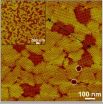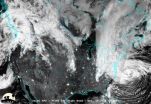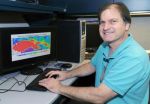(Press-News.org) AUSTIN, Texas — Since the age of dinosaurs, most species of day-active mammals have retained the imprint of nocturnal life in their eye structures. Humans and other anthropoid primates, such as monkeys and apes, are the only groups that deviate from this pattern, according to a new study from The University of Texas at Austin and Midwestern University.
The findings, published in a forthcoming issue of Proceedings of the Royal Society B, are the first to provide a large-scale body of evidence for the "nocturnal bottleneck theory," which suggests that mammalian sensory traits have been profoundly influenced by an extended period of adaptation to nocturnality during the Mesozoic Era. This period lasted from 250 million years ago to 65 million years ago.
To survive in the night, mammals had a host of visual capabilities, such as good color vision and high acuity, which were lost as they passed through the nocturnal "bottleneck."
"The fact that nearly all living mammals have eye shapes that appear 'nocturnal' by comparison with other amniotes [mammals, reptiles and birds] is a testament to the strong influence that evolutionary history can have on modern anatomy," says Chris Kirk, associate professor of anthropology at The University of Texas at Austin.
According to Kirk, early mammals were predominantly nocturnal during the Mesozoic partly as a strategy for avoiding predation by day-active dinosaurs.
"It's a bit surprising to still see the effects of this long period of nocturnality on living mammals more than 65 million years after non-avian dinosaurs went extinct, but that's exactly what we found," Kirk says.
The research team, led by Margaret Hall, an evolutionary biologist at Midwestern University's Arizona College of Osteopathic Medicine, analyzed one of the largest datasets on eye morphology ever assembled. Using a sample of eyeballs from 266 mammal species, the researchers used a multivariate statistical method to show that mammals active by day or night show only minor differences in eye morphology.
The researchers then compared the eyes of mammals, birds and lizards using the ratio of cornea size and eye length — two functionally important measures of the eye's ability to admit light and form sharp images. These analyses showed that diurnal (only active by day) and cathemeral (active by both day and night) mammals don't differ in their eye shapes. At the same time, both groups have eye shapes that are very similar to those of nocturnal birds and lizards. These results reveal that most day-active mammals have eye shapes that appear "nocturnal" when compared with other vertebrates.
One likely reason for these findings, Kirk says, is that after the extinction of non-avian dinosaurs, some nocturnal mammals became day-active and there was less pressure to evolve eye shapes for acute diurnal vision like those of other day-active vertebrates.
Anthropoid primates are the only mammalian group that re-evolved eye shape for fine detailed daytime vision. Like diurnal birds and lizards, most anthropoids have small corneas relative to eye length as an adaptation for enhanced visual acuity.
Kirk says the study provides a deeper understanding of human sensory systems and our intrinsic connection with our closest living primate relatives: the monkeys and apes.
"Humans and other anthropoid primates are so dependent on vision for everything that they do," Kirk says. "In this case, we are radically different from other mammals. We found that the distinctive eye shapes that set humans apart from most other mammals evolved a long time ago — way back with the origin of anthropoid primates."
INFORMATION: END
URBANA –Many young Jamaican immigrants are succeeding in the United States precisely because they remain strongly tied to Jamaican culture, said University of Illinois professor Gail M. Ferguson.
"Although many of these youths have forged a unique tricultural identity that draws from their Jamaican culture, African-American culture, and mainstream European American culture, the important factor in their academic and behavioral success is retaining strong ties to their Jamaican background," she said.
To learn how Jamaican immigrant teens were adjusting to life in their ...
Proteins are able to self-assemble into a wide range of highly ordered structures that feature a diverse array of properties. Through biomimicry - technological innovation inspired by nature – humans hope to emulate proteins and produce our own version of self-assembling molecules. A key to accomplishing this is understanding how protein-folding – a process critical to the form and function of a protein – is extended from individual proteins to complex assemblies.
Researchers with the U.S. Department of Energy (DOE)'s Lawrence Berkeley National Laboratory (Berkeley Lab) ...
VIDEO:
This animation of satellite imagery shows the life of Hurricane Sandy from its development in the Caribbean Sea on Oct. 21, through its track up the US East coast and...
Click here for more information.
Hurricane Sandy is giving up the ghost on Halloween over Penn. As the storm weakened to a remnant low pressure area the NASA GOES Project released an animation of NOAA's GOES-13 satellite imagery covering Hurricane Sandy's entire life.
The GOES-13 satellite is managed ...
As Hurricane Sandy made a historic landfall on the New Jersey coast during the night of Oct. 29, the Visible Infrared Imaging Radiometer Suite (VIIRS) on NASA/NOAA's Suomi National Polar-orbiting Partnership (NPP) satellite captured this night-time view of the storm. This image provided by University of Wisconsin-Madison is a composite of several satellite passes over North America taken 16 to18 hours before Sandy's landfall.
The storm was captured by a special "day-night band," which detects light in a range of wavelengths from green to near-infrared and uses filtering ...
The mineral properties of the aerosol particles and the wavelength distribution of incident light combine to determine whether a dust particle reflects radiation and cools the local atmosphere, absorbs radiation and warms the local atmosphere, or both. While scientists have a good handle on dust's primary effect of reflecting and cooling at the visible wavelengths, the smaller influence of absorbing and warming at the longer infrared wavelengths has remained more of an uncertainty – and most climate models either underestimate it or do not include it at all.
When the ...
Interventions designed to improve core deficits in children with autism spectrum disorders are supported by varying levels of evidence, highlighting the need for well-designed studies to better evaluate the interventions, according to a new RAND Corporation study.
Researchers found that when they evaluated the past research on a wide variety of interventions aimed at improving core deficits in social/communication, language, behavior and adaptive skills, the evidence of efficacy ranged from moderate to insufficient. The findings are published in the November edition of ...
(Boston) - In the United States, the cost paid for statins (drugs to lower cholesterol) in people under the age of 65 who have private insurance continues to exceed comparable costs paid by the government in the United Kingdom (U.K.) by more than three fold. These results from Boston University's Boston Collaborative Drug Surveillance Program, are a follow up of an ongoing comparison of prescription drug costs between the U.S. and U.K. The initial results reported on relative drug costs in 2005. The current updated results for 2009 appear this week in the journal Pharmacotherapy. ...
People who undergo repeated surgeries to remove glioblastomas — the most aggressive and deadliest type of brain tumors — may survive longer than those who have just a one-time operation, new Johns Hopkins research suggests.
Glioblastoma, the brain cancer that killed Sen. Edward Kennedy, inevitably returns after tumor-removal surgery, chemotherapy, and/or radiation. The median survival time after diagnosis is only 14 months. With recurrence a near certainty, experts say, many have questioned the value of performing second, third or even fourth operations, especially given ...
Results of a Johns Hopkins study suggest that individuals with schizophrenia are significantly more likely to live longer if they take their antipsychotic drugs on schedule, avoid extremely high doses and also regularly see a mental health professional.
Psychiatrists have long known that people with schizophrenia who stick to a drug regimen have fewer of the debilitating delusions and hallucinations that are hallmarks of this illness. But there have been concerns about whether some of the known side effects of the medications — increased risk of cardiovascular disease ...
Understanding Workplace Sexual Harassment
No one should ever be subjected to a situation where they feel unsafe at work. Sexual harassment can have huge negative effects not only on individual workers, but on the workplace as a whole.
Understanding what sexual harassment is can go a long way toward making a workplace safer. Many employees don't take action to stop sexual harassment because they aren't fully aware of their rights. In other cases, a supervisor or coworker perpetrating the harassment may not even be aware that their conduct is both harmful and illegal.
What ...



